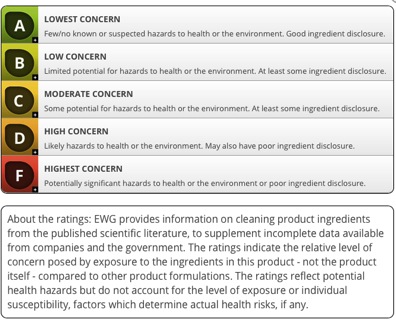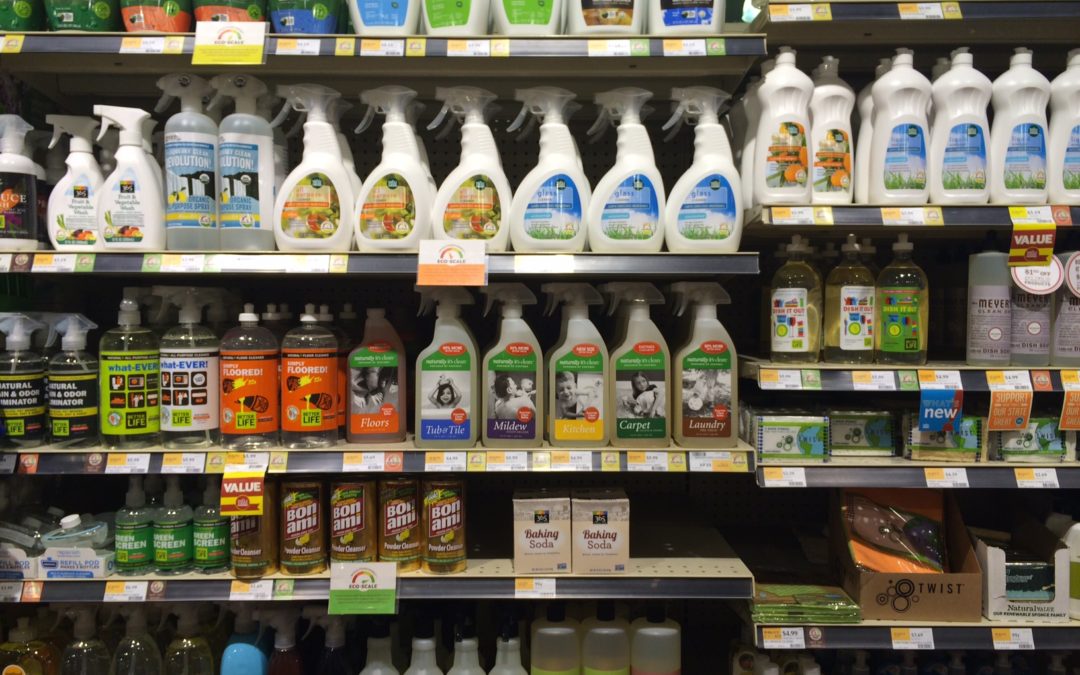Let’s start with the obvious question: what is wrong with household cleaners? The big picture answer, which will span the rest of the tips in this Season, is that there are at least 83,000 chemicals on the market today, and for the most part they are not well regulated. And the simple truth is that exposure to chemicals is linked to cancer, birth defects, asthma, allergies, skin reactions, reproductive disorders…the list goes on. Sometimes illnesses stem from over exposure (acute), which is an immediate one-time reaction that can trigger chronic illness; sometimes illnesses come from long-term exposure that builds up over time. The problem is, we do not know!
Why? First, ingredients often are not disclosed. Unlike packaged food, cosmetics, and personal care products, manufacturers of cleaning supplies are not required to list the chemical ingredients on consumer product labels (though many do).
Second, even if we do know the ingredients, it would be very difficult to even conduct a controlled experiment, because there are too many uncontrolled variables (we aren’t just exposed to one chemical in our lifetime), and we do not typically conduct experiments on humans!
The fact is that many chemicals actually do the job of cleaning pretty well, so that is how they are marketed. Nobody actually goes into a store and asks for the most hazardous product on the shelf – they just want to get the job done.
The United States Congress enacted legislation to regulate the safety of chemicals with the passage of the Toxic Substances Control Act in 1976, which has been governing chemical policy since then through the U.A. Environmental Protection Agency (EPA). The EPA itself recognizes that “the current chemicals management law needs to be strengthened.” In a nutshell, the EPA can only restrict chemical usage if it is proven to be unsafe – and that takes data which is difficult to obtain, time, and money.
Many people argue that the EPA should not allow chemicals to be included in household products unless and until they are proven to be safe. But that’s not how it is. So, we need to take it upon ourselves to understand what products are safe and which ones to avoid.
But with the overwhelming number of the choices on the shelf, how? The best resource I have found is the Environmental Working Group’s (EWG) online guide to healthy cleaning. As of July, 2014, their guide provides information and safety assessments for 2,109 products, 197 brands, and more than 1,000 ingredients across the categories of all-purpose cleaners, laundry detergents, dishwashing, floor care, bathroom, and kitchen, and furniture cleaners. Through thorough research, EWG scores products by asking four questions:
-
- Does the product contain hazardous substances? (This is often difficult when the ingredients are not disclosed, but they dig deep.)
- Does the manufacturer disclose the ingredients on its product for consumers to read?
- Do other factors come in to play, such as regulation violation?
- How does this product rate overall? They translated final product scores into letter grades familiar to most readers. An “A” indicates very low toxicity to health and the environment and extensive ingredient disclosure. An “F” means the product is highly toxic or makes little to no ingredient disclosure. A “C” indicates an average cleaner that poses no overt hazards and provides some disclosure of ingredients.
The screen shot below of the EWG Guide to Healthy Cleaning shows the results of their tests on 416 all-purpose cleaners. What is shocking and sad to me is that over 68% scored a D or F, and only 15% got a B or A! (Note that EWG does not test or score for the effectiveness of the cleaners.)
So, what can we do? One solution is to make our own cleaners so we know what ingredients are going into them. The all-purpose cleaner I like to make and use at home is a recipe from Clean House, Clean Planet by Karen Logan and can be found on the Food.com website:
Ingredients:
A clean 16 oz. trigger spray bottle (or 32 oz. and double the recipe)
1 teaspoon of borax
2 tablespoons of vinegar
¼ cup of home soap or Dr. Bronner’s soap
Essential oil of lemon, tea tree, or lavender (optional)
Hot water (enough to fill bottle)
Instructions:
- Mix the vinegar and borax in the spray bottle.
- Fill the bottle with water and shake to dissolve the borax.
- Add soap.
- Add essential oil (optional) – 5-10 drops
- Gently shake the mixture.
Another benefit of making your own cleaner is that it will save you money. While the up-front purchase of all the ingredients can cost in the $20 range, will not need to buy another $4.99 bottle of multi-purpose cleaner for years. For example:
- Spray bottle = $1.83 online
- Borax = $3.99 for 12 oz. at Target
- Vinegar = $1.64 for 32 oz. of Heinz vinegar at Walmart
- Soap = $11.99 for 32 oz. of Dr. Bronner’s soap at Whole Foods
You can make 16 spray bottles full and still have a lot of leftover borax and vinegar! That’s only $1.21 per bottle, and the cost will continue to go down as you reuse the same bottle (helping reduce waste as well). Plus, you’re getting the health benefit of using non-toxic, basic ingredients.
For other types of cleaners, the American Lung Association Health House suggestions include the following:
- Make your own furniture and floor polish by mixing one part lemon juice with two parts vegetable oil.
- Clean your oven in a healthy way by using a solution of baking soda dissolved in water.
- Use baking soda for rug and carpet odor removal.
- For a toilet bowl cleaner, pour in 1 cup of vinegar and leave overnight. Brush the next day.
But let’s face it: many of us do not really have the time or inclination to make our cleaners. So now what can you do? You can look for “green” label certifications for household cleaners. In LEED (Leadership in Energy and Environmental Design, the internationally recognized green building rating system which my company specializes in to help business become more sustainable), there are just two certifications for household cleaners that are acceptable:
Green Seal. According to their website, “We develop life cycle-based sustainability standards for products, services and companies and offer third-party certification for those that meet the criteria in the standard. Green Seal has been actively identifying and promoting sustainability in the marketplace, and helping organizations be greener in a real and effective way since 1989.
UL ECOLOGO. According to their website, “ECOLOGO Certifications are voluntary, multi-attribute, lifecycle based environmental certifications that indicate product has undergone rigorous scientific testing, exhaustive auditing, or both, to prove its compliance with stringent, third-party, environmental performance standards.”
While both of these are noteworthy and have online databases to search for products, unfortunately, there are not many household cleaning products that currently have either certification.
So, since the certifications aren’t that helpful in the aisles of Target and Walmart, and EWG’s database might be tough to access there too, I’ve done a little of my own research on brands that typically get As and Bs as well as those that get Ds and Fs for most of their products:

EWG’s best scoring All-Purpose Cleaners Brands (mostly As and Bs)
Bon Ami
Ecover
Green Shield
Ballard Organics
Arm & Hammer
EWG’s worst scoring All-Purpose Cleaners Brands (mostly Ds and Fs)
Clorox / Formula 409
Method
Greenworks
Mr. Clean
Windex
Up & Up
Fabuloso
Spic and Span
EWG’s exceptions/surprises
- Seventh Generation, which prides itself on helping to create a toxin-free home, does not always score well. This was one of the “noteworthy” findings from EWG’s research:
The Seventh Generation brand gets good scores overall in EWG’s Guide to Healthy Cleaning, but there are exceptions. A few products score poorly because they contain the preservative methylisothiazolinone and others because the ingredients include the cleaning agent sodium borate. Methylisothiazolinone is toxic in the environment and may cause allergic reactions. Sodium borate is listed as an endocrine disruptor in the European Union.
- Lysol was another noteworthy exception:
Some safety-conscious consumers look askance at Lysol products, but a few Lysol items scored OK in EWG’s Guide to Health Cleaning. This tub and tile cleaner rates a B. A few Lysol all-purpose cleaners also scored well. This product uses relatively benign glycolic and citric acids and well-disclosed surfactants to get the job done, unlike other bathroom cleaners that use asthma-causing “quats.” Still, there’s room for improvement, since this tub cleaner doesn’t list the specific ingredients in its “fragrance”.
Conclusions
This is a confusing subject, so I’ll try to bottom-line it:
- Read the label. It is has an EPA #, then it is classified as a pesticide and do not buy it. Be careful if it says “hazard” or “danger!”
- Try to avoid chemically dangerous products. About 80%-90% of household cleaning chores can be done without chemicals. When you do need the tough stuff,
- Only buy and use what you need
- Store it properly where children cannot access it
- Do not use around pets or children
- Follow guidelines for proper disposal
- Trust your nose. If it smells bad, it probably is bad. If sniffing it makes your eyes water or your skin itch, don’t bring it into your home.

